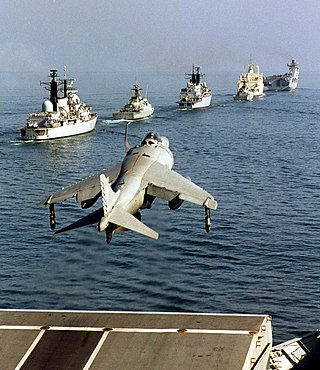
A short take-off and vertical landing aircraft is a fixed-wing aircraft that is able to take off from a short runway and land vertically. The formal NATO definition is:
A Short Take-Off and Vertical Landing aircraft is a fixed-wing aircraft capable of clearing a 15 m obstacle within 450 m of commencing take-off run, and capable of landing vertically.

The British Aircraft Corporation (BAC) was a British aircraft manufacturer formed from the government-pressured merger of English Electric Aviation Ltd., Vickers-Armstrongs (Aircraft), the Bristol Aeroplane Company and Hunting Aircraft in 1960. Bristol, English Electric and Vickers became "parents" of BAC with shareholdings of 20%, 40% and 40% respectively. BAC in turn acquired the share capital of their aviation interests and 70% of Hunting Aircraft several months later.

Hawker Siddeley was a group of British manufacturing companies engaged in aircraft production. Hawker Siddeley combined the legacies of several British aircraft manufacturers, emerging through a series of mergers and acquisitions as one of only two such major British companies in the 1960s. In 1977, Hawker Siddeley became a founding component of the nationalised British Aerospace (BAe). Hawker Siddeley also operated in other industrial markets, such as locomotive building and diesel engine manufacture. The company was once a constituent of the FTSE 100 Index.

The Rolls-Royce Pegasus, formerly the Bristol Siddeley Pegasus, is a British turbofan engine originally designed by Bristol Siddeley. It was manufactured by Rolls-Royce plc. The engine is not only able to power a jet aircraft forward, but also to direct thrust downwards via swivelling nozzles. Lightly loaded aircraft equipped with this engine can manoeuvre like a helicopter. In particular, they can perform vertical takeoffs and landings. In US service, the engine is designated F402.

The Rolls-Royce Spey is a low-bypass turbofan engine originally designed and manufactured by Rolls-Royce that has been in widespread service for over 40 years. A co-development version of the Spey between Rolls-Royce and Allison in the 1960s is the Allison TF41.

The Armstrong Whitworth Argosy was a British post-war transport/cargo aircraft; it was the final aircraft to be designed and produced by aviation company Armstrong Whitworth Aircraft. Although given different internal design numbers, the AW.650 civil and AW.660 military models were, for most practical purposes, the same design, while both models also shared the "Argosy" name.
Sir W. G. Armstrong Whitworth Aircraft Company, or Armstrong Whitworth Aircraft, was a British aircraft manufacturer.

The Dassault Mirage IIIV, also spelled Mirage III V, was a French vertical take-off and landing (VTOL) prototype fighter aircraft of the mid-1960s developed and produced by Dassault Aviation.
The Hawker Siddeley P.1154 was a planned supersonic vertical/short take-off and landing (V/STOL) fighter aircraft designed by Hawker Siddeley Aviation (HSA).

The Dornier Do 31 is an experimental vertical take-off and landing (VTOL) jet-propelled transport designed and produced by West German aircraft manufacturer Dornier.

The VFW VAK 191B was an experimental German vertical take-off and landing (VTOL) strike fighter of the early 1970s. VAK was the abbreviation for Vertikalstartendes Aufklärungs- und Kampfflugzeug. Designed and built by the Vereinigte Flugtechnische Werke (VFW), it was developed with the purpose of eventually serving as a replacement for the Italian Fiat G.91 then in service with the German Air Force. Operationally, it was intended to have been armed with nuclear weapons as a deterrent against aggression from the Soviet Union and, in the event of a major war breaking out, to survive the first wave of attacks by deploying to dispersed locations, rather than conventional airfields, and to retaliate against targets behind enemy lines.

The Hawker Siddeley HS-121 Trident is a British airliner produced by Hawker Siddeley. In 1957, de Havilland proposed its DH.121 trijet design to a British European Airways (BEA) request. By 1960, de Havilland had been acquired by Hawker Siddeley. The Trident's maiden flight happened on 9 January 1962, and it was introduced on 1 April 1964, two months after its main competitor, the Boeing 727. By the end of the programme in 1978, 117 Tridents had been produced. The Trident was withdrawn from service in 1995.

The Rolls-Royce RB.162 is a lightweight British turbojet engine produced by Rolls-Royce Limited. Developed in the early 1960s, it was specially designed for use as a lift engine for VTOL aircraft but was also used in a later variant of the Hawker Siddeley Trident airliner as an auxiliary boost engine. A smaller related variant, the RB.181 remained a design project only, as did a turbofan version designated RB.175.

The Rolls-Royce RB.141 Medway was a large low-bypass turbofan engine designed, manufactured and tested in prototype form by Rolls-Royce in the early-1960s. The project was cancelled due to changes in market requirements that also led to the development and production of the smaller but similar Rolls-Royce Spey, and the cancellation of the Armstrong Whitworth AW.681 military transport aircraft project.

The Rolls-Royce/MAN Turbo RB.193 is a vectored thrust turbofan engine designed and manufactured by Rolls-Royce and MAN Turbo in the mid-1960s. The engine test flew in its sole application, the VFW VAK 191B VTOL fighter aircraft but production did not follow after cancellation of the associated aircraft project.

The Hawker P.1121 was a British supersonic fighter aircraft designed, but never fully completed, by Hawker Siddeley during the mid-1950s. It was designed by a team headed by Sir Sydney Camm.

The Hawker Siddeley HS.141 was a 1970s design study and submission for a British V/STOL airliner requirement. Designed by Hawker Siddeley Aviation and tested in wind tunnels neither prototypes nor production aircraft were produced.

NBMR-3 or NATO Basic Military Requirement 3 was a document produced by a North Atlantic Treaty Organisation (NATO) committee in the early 1960s detailing the specification of future combat aircraft designs. The requirement was for aircraft in two performance groups, supersonic fighter aircraft (NBMR-3a) and subsonic fighter-bomber aircraft (NBMR-3b). Both requirements specifically stated the need for V/STOL performance as the contemporary fear was that airfields could be overrun or disabled through Eastern Bloc hostile actions and that dispersed operating bases would be needed. Germany was planning replacements for the Fiat G.91 and Lockheed F-104G Starfighter using the new aircraft types.
Robert Edward Grigg was a British aerospace engineer, and was the chief designer of the highly-successful British Aerospace 146.
















